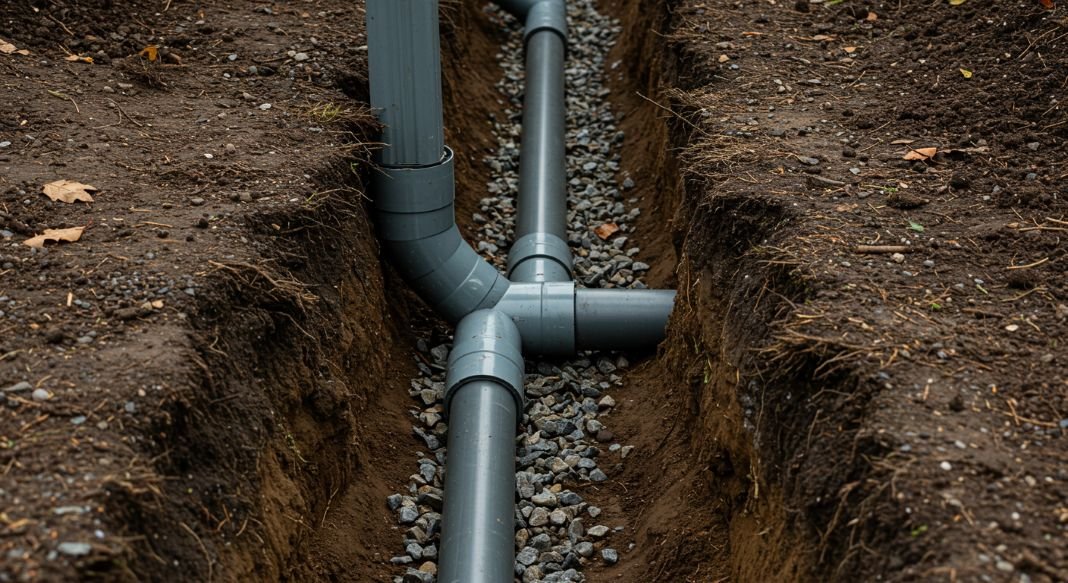Signs Your Underground Downspout Drain Is Clogged and What to Do About It
When an underground downspout drain gets clogged, rainwater has nowhere to go, leading to overflowing gutters, pooling water, and potential damage to your home’s foundation. If left unchecked, this can cause erosion, basement leaks, and even structural issues. Spotting the warning signs early can save you from expensive repairs. Here’s how to tell if your underground downspout is clogged and what you can do to fix it.
Here's What We Have Covered In This Article
How to Tell If Your Underground Downspout Is Clogged
A clogged underground downspout can create several noticeable problems. If you spot any of these signs, your drainage system may need attention.
Why Are My Gutters Overflowing?
If water spills over the edges of your gutters, it might not be due to leaves or debris in the gutters themselves. A clog in the underground downspout can cause water to back up, leading to overflowing gutters even when they appear clean.
Why Isn’t Water Coming Out of My Downspout?
Most underground downspouts drain onto the street, a driveway, or a designated runoff area. If no water is flowing out during a rainstorm, something may be blocking the pipe. A clog could be causing the water to back up instead of exiting where it should.
What Causes Water Damage in the Basement?
When a downspout doesn’t drain properly, water can seep into the foundation. Over time, this can cause leaks, mould, and structural damage in basements or crawl spaces. If you notice damp walls, a musty smell, or standing water, your underground drainage system could be the culprit.
Why Is Water Leaking from the Downspout Seams?
If water is spilling from the joints and seams of your downspout instead of flowing through the pipe, it’s a sign of a blockage. Water pressure builds up behind the clog, forcing it to escape from weak points in the system.
What Causes an Underground Downspout to Clog?
Several things can block an underground downspout, making it unable to drain water properly.
Leaves and Debris Buildup
Leaves, twigs, and dirt can accumulate in the pipe, especially if the gutters aren’t cleaned regularly. Over time, this debris compacts, forming a solid blockage.
Tree Roots Growing into the Pipe
Tree roots naturally seek out moisture. If there’s a tiny crack in the underground pipe, roots can grow into it, eventually blocking water flow entirely.
Mud and Silt Accumulation
Fine particles from runoff can settle inside the pipe, creating a thick layer of silt. This buildup reduces drainage capacity and can eventually lead to a complete blockage.
Rodent and Pest Nests
Small animals like rodents or insects sometimes build nests inside the drainage pipe, obstructing water flow. If you notice unusual noises or signs of animal activity near the downspout, this could be the reason.
How to Fix a Clogged Underground Downspout
If your underground downspout is clogged, clearing it quickly will prevent further damage to your home. Here are some solutions to consider.
Can You Clear a Clog Yourself?
For minor clogs, try using a garden hose to flush the debris out of the pipe. Insert the hose into the downspout and run water at full pressure. If the clog doesn’t move, a plumber’s snake or a high-pressure drain bladder may help break it apart.
When Should You Call a Professional?
If water still isn’t draining properly, the clog may be deeper inside the system or caused by tree roots. A professional drain cleaning service has specialised equipment like hydro-jetting to remove tough blockages without damaging the pipes.
How to Prevent Underground Downspout Clogs
Keeping your drainage system clear will help avoid costly repairs and water damage in the future. Here’s how to maintain it properly.
Regular Gutter Cleaning
Clean your gutters at least twice a year, especially in autumn when leaves fall. Installing gutter guards can also help prevent debris from entering the downspout.
Check for Signs of Blockages
During heavy rain, inspect your downspout’s exit point to ensure water is flowing freely. If you notice slow drainage or no water coming out, investigate the cause immediately.
Flush the Drain Annually
Once a year, use a hose to flush out any minor buildup in the underground downspout. This helps remove sediment and small debris before they turn into a clog.
Trim Nearby Trees and Shrubs
If you have trees close to your underground downspout, consider trimming their roots or installing a root barrier to prevent them from growing into the pipe.
Need Help with a Clogged Downspout?
If you’re dealing with a clogged underground downspout or want to prevent future problems, professional drain cleaning can keep your system flowing smoothly. Contact a reliable drainage service to clear blockages and inspect your system before costly water damage occurs.





